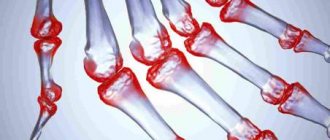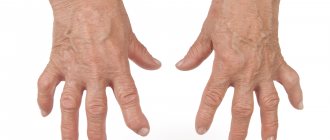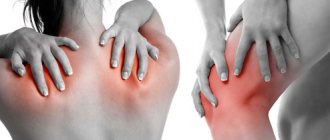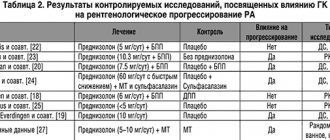Yoga against arthritis
As a result of infection, metabolic disorders, injuries, joints become inflamed, destroyed, deformed, pain in the limbs, stiffness and swelling occurs. In medicine, the disease is called arthritis.
Yoga is a great way to treat arthritis.
In addition to physiological improvement, practicing Eastern philosophy will help reduce stress associated with the disease, reduce pain, and increase the flexibility of articular joints.
Is Eastern practice useful for people suffering from joint disease?
Yoga consists of spiritual, mental and physical practices where a person is able to control the physiological functions of the body through exercise without excessive effort.
Patients with arthritis, while doing yoga, perform a kind of gymnastics. By loading inflamed joints, a person gives them mobility, stimulates regenerative and metabolic processes in the body, thereby restoring cartilage tissue, strengthening muscles and joints, improving blood supply, reducing pain, reducing swelling, toning muscles, and losing excess weight.
Medical studies have shown that with arthritis, those who regularly practice yoga have improved not only their physical but also their psycho-emotional state. Muscle spasms go away, joints work normally - they are mobile.
General recommendations
- You should start your yoga routine with simple and easy exercises.
- Don't try to pull your muscles too hard or twist into difficult poses. Asanas go slowly and smoothly.
- If a pose causes pain, stop moving. Don't let yourself feel uncomfortable.
- Practical classes should be built on a regular basis, i.e. at least four times a week. Then the positive effect is achieved after 6-8 weeks.
- Stop exercising if the pain becomes intense, or if the pain worsens after you finish exercising and does not subside for several hours.
- It is advisable to carry out the exercise under the supervision of a professional trainer - he controls the process of performing the exercises, which will help to avoid injury.
- Do yoga classes in the morning, before your first snack, or after a 2-hour break after your evening meal.
Let's start classes
Nothing should distract you - complete silence without extraneous sounds. Prepare an anti-slip mat (mat), loose-fitting training clothes made from natural textiles. Legs are bare - without shoes or socks. Ventilate the room before starting exercises.
The first step is a light warm-up 10-minute exercise; during this period, the muscles and joints prepare for the load. Do not forget to monitor your breathing - it is smooth and deep, without delays or intense inhalations/exhalations. All movements are slow and smooth, without harshness, without putting pressure on sore joints. It is forbidden to bend/unbend them by force. Relaxation exercises will gently stretch the muscles and give the joints a physical load without damaging them.
Healing techniques
A lot of effective methods have been developed to relieve pain and restore mobility in arthritic diseases. You should not select them yourself; consult your primary care physician or personal trainer - they have experience working with people suffering from joint inflammation. It is enough to perform 2 asanas (postures) per day.
Learn new positions, training time increases gradually. One yoga session – from 30 to 60 minutes.
- Hero pose. Virasana will help with arthritis of the knee and ankle joints, with inflammatory changes in the periarticular tissues that are involved in the movement of the shoulder joint (humeral periarthritis). The exercise tones the muscles and gently stretches them. Get down on your knees, legs apart, sit with your buttocks on the floor (between your heels). Hands lie on your knees, palms up. Keep your back straight, try to pull your shoulders back as much as possible. Hold this position for a few seconds until a slight sensation of pain occurs.
- Bow pose. Dhanurasana will stretch and strengthen the muscles in the shoulder, ankle and knee areas. The exercise is performed on the stomach, the feet of the bent legs are pressed to the buttocks with the help of the hands. Slowly arch your back. 20 seconds is enough to hold yourself in this position.
- Bridge Pose. Setubandhasana will relax the joints of your legs and shoulders. Lying straight on your back, extend your arms down your torso. We bend our knees and begin to lean on our feet and straight arms, raising our torso. 20 seconds and up to a minute is enough to hold in this position.
- Butterfly pose. Titaliasana will help improve blood circulation in the hip area and warm up the joints. The exercise is performed sitting with a straight back. Slowly bend your knees, trying to bring your feet together. Use your hands to pull them closer to your body. We don't bend our back. The knees are spread as far apart as possible. Stay in this position for 40-60 seconds. We slowly and smoothly lower our torso forward, trying to touch our forehead to the floor.
With the help of yoga, they warm up the hands, feet, spine, and prevent deformation, inflammation and pain in the joints.
- We work with brushes: rotate the hands, fingers clenched into a fist. Alternately stretch out the fingers on each hand. Just knock your fists together about 30 times. Perform palm clapping.
- We develop the feet and hip joints. Stand with your feet shoulder-width apart. Bend your leg and lift it, and rotate your foot up to 10 times. We smoothly stand on our toes, lingering slightly at the top. The action lasts 15 seconds.
After classes, you should feel a surge of vigor and energy, and the stiffness of your limbs will gradually decrease.
Do spiritual gymnastics, combining them with body exercises, regardless of age.
Be healthy! Author: K.M.N., Academician of the Russian Academy of Medical Sciences M.A. Bobyr
Benefits of yoga for arthritis
Yoga provides the necessary exercise without excessive effort
Yoga classes for arthritis can be perceived as therapeutic exercises: they give diseased joints the necessary load to maintain mobility and stimulate regenerative processes in the body, helping to restore cartilage tissue. Yoga for arthritis has a number of beneficial effects that allow the body to more successfully fight the disease:
- strengthens muscles and joints;
- launches recovery processes;
- improves blood circulation;
- increases flexibility;
- reduces pain;
- helps relieve swelling;
- stimulates metabolic processes;
- helps eliminate excess weight;
- tones muscles;
- gives strength.
Yoga also helps to calm the nervous system and restore mental balance, which is extremely important in the treatment of any serious illness: nervous stress and depressive conditions slow down the recovery process.
Studies of the effect of yoga on the body in arthritis have shown that people who regularly engage in this practice have significantly improved their physical and psycho-emotional state. People with arthrosis showed a decrease in rheumatoid factor after yoga classes. Some patients with rheumatoid arthritis, after long practice of yoga, were confident that they had completely cured their disease: the exercises relieved muscle spasms, eliminated pain and returned normal mobility to the joints.
One of the benefits of yoga is the ability to perform stretching and relaxation exercises while sitting or lying down, making them more comfortable for patients experiencing severe discomfort. This becomes one of the incentives to exercise regularly: people with arthritis often give up traditional gymnastics, despite the fact that this can aggravate their condition.
How much time do you need to study
Exercise should bring a surge of energy
As with traditional therapeutic exercises, for arthritis you should start with short ten-minute exercises, performing 2 simple asanas per day. Minimal loads will not bring severe discomfort to sore joints, which is why many beginners lose the desire to exercise. Every day you can consistently learn new poses, gradually increasing the training time and the number of asanas.
Having fully mastered all available poses, you can set your own load yourself, focusing on how you feel and the reaction of sore joints to the load. Exercises should bring a surge of energy, a feeling of relaxation and a decrease in stiffness: if after them the body becomes noticeably tired and joint pain intensifies, the load should be reduced. One yoga session can take about 30-60 minutes.
General rules and recommendations
You should do yoga at least 4 times a week
Yoga against arthritis should be a set of light exercises: you should not pull the muscles too hard and try to perform difficult poses - this will do more harm than good. Practice should be regular, at least 4 times a week. With systematic exercise, the first positive results appear after 6-8 weeks.
Minor pain in the joints may occur during training - mild discomfort also occurs during traditional therapeutic exercises, and you just need to overcome it. You should not continue to exercise if the pain becomes intense, or if it intensifies after finishing the workout and does not subside within several hours. It is advisable to exercise under the supervision of a professional trainer: he will monitor the correct execution of the exercises and help avoid injuries.
It is best to do yoga in the morning before breakfast, in complete silence. Training should begin no earlier than 2 hours after the last meal. Before you start the exercises, you need to do light warm-up exercises to prepare your muscles and joints for work.
You must exercise barefoot on a special non-slip mat in loose clothing made from natural fabrics. Before starting classes, you should ventilate the room. During exercises, it is important to monitor your breathing: it should be even and deep enough. You cannot hold your breath, breathe shallowly, or take intense inhalations and exhalations. Both the preliminary warm-up and the main exercises should be performed slowly and smoothly: sudden movements, pressure on sore joints and attempts to bend and straighten with force are strictly prohibited.
Yoga involves not only performing special exercises, but also following a special diet and following personal hygiene rules.
It is recommended, if possible, to exclude from the diet fermented milk products, fish, alcohol, confectionery and foods that can cause constipation. You should limit your consumption of bananas, tea and coffee. You need to eat in portions - at least 4 times a day. The menu should definitely include fresh vegetables and fruits, boiled eggs, and bran bread. Proper nutrition in combination with exercise will speed up metabolic processes, which will have a beneficial effect on the entire body and help it fight the disease.
The most effective asanas
Anjaneyasana or Rising Moon Pose
For any form of arthritis, including rheumatic and rheumatoid, preference should be given to simple, relaxing exercises that will help gently stretch the muscles and give the joints a physical load without damaging them. The following poses are most effective for joint diseases:
- Anjaneyasana or rising moon pose. Useful for arthritis of the hip and shoulder joints, gently stretching them. You need to raise your arms above your head, clasping your palms together, gently lower one knee to the floor and bend it, gently pressing your body down. You should stay in this position for 30-60 seconds.
- Virasana or hero pose. Effective for arthritis of the knee and ankle joints, as well as for glenohumeral periarthritis. Tones muscles and gently stretches them. You need to kneel with your legs apart and lower your buttocks to the floor between your heels, place your hands on your knees, palms up. Your back should be straight, your shoulders should be pulled back. You can remain in this position until pain appears.
- Bharadvajasana or staff pose. Helps restore joints after injury and inflammation. You need to sit with your buttocks on the floor, straightening your legs. After this, the knees are carefully bent to the right side, the feet are leaning against the thigh. At the same time, you should turn your body about 45 degrees in the opposite direction, while your right hand should rest on your left thigh near your knee. You need to take your left hand behind your back and try to grab the elbow of your right hand with your fingers, while simultaneously turning your head to the right and looking at your right shoulder. You should remain in this position for 10 to 40 seconds. After this, the exercise should be repeated for the opposite side.
- Dhanurasana or bow pose. Helps stretch and strengthen the muscles of the shoulders, ankles and knees. You need to lie on your stomach, bend your legs, pointing your feet towards your buttocks and clasp them with your hands, then slowly pull them towards you, arching your back. You should hold this position for about 20 seconds.
- Setubandhasana or bridge building pose. Relaxes the joints of the legs and shoulders. To perform this, you need to lie on your back, arms extended along your body, legs should lie straight. The knees bend, the support is transferred to the feet and completely straight arms, it is necessary to slowly raise the lower part of the body, starting from the tailbone. After this, you need to bring your hands under your buttocks and stretch your body up as far as possible. The pose is held for 20 to 60 seconds, after which the back is smoothly and carefully lowered to the floor.
There are many more effective poses that can help relieve pain and restore mobility from arthritis. You can choose them together with your doctor or personal trainer who has experience working with people suffering from joint inflammation.










